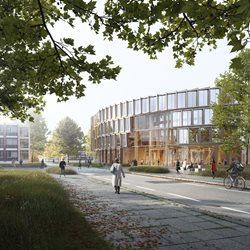
Henning Larsen wins the international design competition for World Leading Research Center CERN.
Crafting a 'nature campus' identity for CERN’s Prevessin Campus on the French side of the France-Switzerland border, the circular B777 building stands at the edge of the forest and park, inviting scientists and guests to the area.
Henning Larsen's design transcends the traditional industrial, laboratory context. CERN B777 is immersed in nature, with biogenic materials and low-carbon design prioritized to generate community, collaboration, and wellbeing.
Center of existence
The circular design, with a sheltered courtyard at its heart, seamlessly connects forest, park and plaza. Office, laboratory, and workshop space are combined within the open timber building, offering constant connection to nature.
Henning Larsen’s design echoes CERN’s original mission to unite scientists in the collective pursuit of knowledge. Founded in 1954, 12 European countries came together to establish the largest research facility for particle physics. Today, CERN remains at the epicenter of scientific innovation, home to the world’s largest and most complex research instruments, notably the powerful particle accelerator The Large Hadron Collider.

Public plaza
Drawing inspiration from the protected plazas at the heart of nearby Alpine villages, the central courtyard of the building extends the outdoor comfort season, intentionally designed to remain open and permeable, acting as a social hub. This space serves as an extension of the office and indoor activities, seamlessly connecting lab zones to informal meeting areas surrounded by greenery and offices in the inner circle enjoy views into nature. This central hub acts as the gateway to the restaurant, featuring outdoor seating and a kitchen garden with aromatic plants. During summertime, the leaves provide shade, in winter, the canteen terrace welcomes the rays of the sun, and in rainy weather, the passage functions as a covered space.
Connected landscapes
Merging the surrounding landscape creates an extended biodiversity corridor, encouraging life to thrive, 'slow' paths and new routes around the campus will encourage people to connect with nature.
The landscape surrounding the building will take on a more urban character featuring islands of wild grass inspired by the Jura mountains and space for bike paths, bike parking, and charging stations.
"Our vision is to craft a dynamic workspace at the heart of nature—a place where wellbeing, collaboration, and knowledge thrive. It's not just an ordinary office; the circular design serves as a symbolic marker, creating a new cultural center for the entire campus in a formerly rigid, orthogonal, research park,” says Søren Øllgaard, Partner and Design Director, Henning Larsen.
Reducing embodied carbon, as well as operational carbon, is prioritized throughout the design, evaluating the effect the building will have on the environment through life-cycle assessments. To accommodate the possibility of reusing and recycling the structural materials, the structure is designed for disassembly by using simple, demountable and mechanical connections.
The three-dimensional facade maximizes daylight and natural views whilst also creating self-shade to prevent solar radiation, resulting in lower energy consumption from cooling.
***
Pres release and images courtesy of Henning Larsen



 0
0
comment